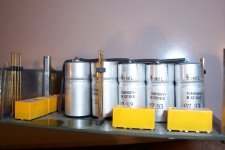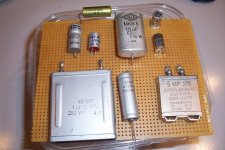hypothetical
adjective UK /ˌhaɪ.pəˈθet.ɪ.kəl/ US /ˌhaɪ.pəˈθet̬.ɪ.kəl/
imagined or suggested but not necessarily real or true
Does it mean something else in Bulgaria?
Yes, the meaning is the same. I have no objective data to prove anything, so I'm speaking hypothetically.
I appreciate your honesty.
However I'm sure distortion can be measured
I'm not saying it cannot be. I don't have precision equipment for distortion measuring to work with and there is not much I can say about it anyway.
I just hypothetically wonder is there is anything else beside signal distortion that could affect audible differences.
I've participated in at least 20 hearing tests at work alone, from which more than a half were non-sighted without biasing. It's a common practice at our office when we're finalizing audio devices. Including the testing of the effect of coupling capacitors.
I admit I've never tried measuring distortion of a capacitor, I've only read other articles from engineers who did it. But I've found their results to be negligible.
So I wonder. Is it signal distortion that affects the potential differences we hear, or it is something else? Again, hypothetically speaking.
Non-linear distortion and frequency response are the two main issues. We appear to be more sensitive to the latter, and many people have a preference for small but non-zero amounts of the former.
Someone (I forget who) did some tests some years ago. He took a high quality solid-state amp and a high quality valve amp - two quite different technologies but both aimed at sound reproduction. People could tell them apart, which is not surprising. He then added a filter to the SS amp (to model the slightly narrower bandwidth of the valve amp) and a small output resistor (to model the slightly higher output impedance of the valve amp). People could then not tell them apart, yet they were very different amps and would have had very different distortion patterns. The reason they sounded the same was that they now had the same frequency response, and the distortion (although different) was below audible thresholds.
Someone (I forget who) did some tests some years ago. He took a high quality solid-state amp and a high quality valve amp - two quite different technologies but both aimed at sound reproduction. People could tell them apart, which is not surprising. He then added a filter to the SS amp (to model the slightly narrower bandwidth of the valve amp) and a small output resistor (to model the slightly higher output impedance of the valve amp). People could then not tell them apart, yet they were very different amps and would have had very different distortion patterns. The reason they sounded the same was that they now had the same frequency response, and the distortion (although different) was below audible thresholds.
My thoughts are that the experiment was done with a push pull tube amp with negative feedback. Had it been compared against a triode amp or a tube amp with no feedback then results would have been different. Cause the sonic signature would be too far apart for a SS amp to replicate
The "sonic signature" (i.e. distortion pattern) of a PP valve amp with lots of NFB is likely to be quite different from SS. If the valve amp was a typical SET then Carver may have needed to add some second-order distortion to his SS amp to match it. Few people would expect an SET to sound like SS, as the SET typically has large known distortions so is not making a serious attempt at high fidelity sound reproduction. However, a really good SET with high enough power and low enough distortion could probably pass the Carver test - and so be indistinguishable from a valve PP and an SS PP. Such an SET might not be very popular with the normal SET brigade as it would lack the 'musicality' (i.e. low order distortion) which they prefer.
Hi all,
I use PETP caps extensively wherever possible and they are very good. I usually buy K73-16 caps. I recently got PETP caps from Romania and they are labeled K73-16B. The B is addition. They looks to be better made than regular one and Gold in colour. I am attaching a pic here. Does anyone know the difference?

Regards
Sachin
I use PETP caps extensively wherever possible and they are very good. I usually buy K73-16 caps. I recently got PETP caps from Romania and they are labeled K73-16B. The B is addition. They looks to be better made than regular one and Gold in colour. I am attaching a pic here. Does anyone know the difference?

Regards
Sachin
Last edited:
Sachu88,
this is the normal construction of the K73-16 caps, I don't think the colour - silver or gold is relevant.
Linuxguru - missed your posts a few pages back re. construction/materials explanation and the amusing varnishing nonsense, laughter is an important ingredient for an agreeable existence.
Construction has to be an important element in the sonics of this cap. For all the obvious faults in a State Capitalist/command control system, the profit motive was irrelevant, so production cost didn't have the importance of the classic western Capitalist mentality. Where do you see the expensive aluminium shell type construction in even the most expensive western caps - you don't.
Again with size I'm sure you have made a valid point as well.
Very interested in these obscure Japanese caps as well, must check them out - any pointers in where to buy them?
I will soon be changing the caps in my Heybrook Sextet Mk 1V speakers using the K73- 16 caps and externalising the x/overs as well. More heresy - using my air/cored I/c construction + soft sheathing (vibration control) for the internal wiring - all theory should come from practice - I am a proud heretic (at least you don't get burned by priests these days).
this is the normal construction of the K73-16 caps, I don't think the colour - silver or gold is relevant.
Linuxguru - missed your posts a few pages back re. construction/materials explanation and the amusing varnishing nonsense, laughter is an important ingredient for an agreeable existence.
Construction has to be an important element in the sonics of this cap. For all the obvious faults in a State Capitalist/command control system, the profit motive was irrelevant, so production cost didn't have the importance of the classic western Capitalist mentality. Where do you see the expensive aluminium shell type construction in even the most expensive western caps - you don't.
Again with size I'm sure you have made a valid point as well.
Very interested in these obscure Japanese caps as well, must check them out - any pointers in where to buy them?
I will soon be changing the caps in my Heybrook Sextet Mk 1V speakers using the K73- 16 caps and externalising the x/overs as well. More heresy - using my air/cored I/c construction + soft sheathing (vibration control) for the internal wiring - all theory should come from practice - I am a proud heretic (at least you don't get burned by priests these days).
I would be slightly less affirmative about that: for example, take the MKL series, developed in the late fifties or early sixties in what was then the BRD (Western Germany, RFA) by Siemens.For all the obvious faults in a State Capitalist/command control system, the profit motive was irrelevant, so production cost didn't have the importance of the classic western Capitalist mentality. Where do you see the expensive aluminium shell type construction in even the most expensive western caps - you don't.
The construction is absolutely similar: an aluminum tube sealed by epoxy resin:

The performance is comparable to PETP (=mediocre), but there are much better examples of "decadent capitalistic" products:

Top left, another Siemens MKL example, followed by a 147nF polycarbonate from LCC, completely hermetic, 2% tolerance, then (below) a 5520pF polystyrene again made by Siemens in an aluminum case sealed with resin, then a Wima of comparable construction but larger, and then two examples of completely hermetic PS caps in transitor-like case also made by Siemens.
Bottom left, a PIO made by MBLE (subsidiary of Philips), followed by a 47nF metallized paper also MBLE, and finally a 100nF/630V metallized paper made by Siemens.
These are just examples, and you could find many others, both from the western and eastern blocks, and also from non-aligned origins: politics have little to do with the quality of products, and crap was produced everywhere, including both sides of the iron curtain....
PETP is a cheap, general purpose dielectric. As soon as you need some quality, like stability, dielectric absorption, dielectric losses, stability vs. frequency, etc, you have to turn to other alternatives: PC, PP, PS, etc.
The metal sleeve construction had been adopted mostly to slow the ingress of humidity. Nowadays, because the fabrication techniques are much more advanced, such an expedient is not necessary anymore.
For extremely critical applications, completely hermetic models still exist (I have shown a few examples), but they are extremely expensive and use better dielectrics than PETP.
That said, for non-critical applications like coupling, bypassing, etc, mylar caps work perfectly well.
The metal sleeve construction had been adopted mostly to slow the ingress of humidity. Nowadays, because the fabrication techniques are much more advanced, such an expedient is not necessary anymore.
For extremely critical applications, completely hermetic models still exist (I have shown a few examples), but they are extremely expensive and use better dielectrics than PETP.
That said, for non-critical applications like coupling, bypassing, etc, mylar caps work perfectly well.
'Transfer function' The Carver Challenge | Stereophile.comIs a great article. Although with no harsh feelings towards anyone, I wonder if it's possible to obtain objective data from the engineer ( Bob Carver) who did the experiment? A scientific protocol for example?
- Status
- Not open for further replies.
- Home
- Design & Build
- Parts
- Petp Capacitors-one Of The Best?